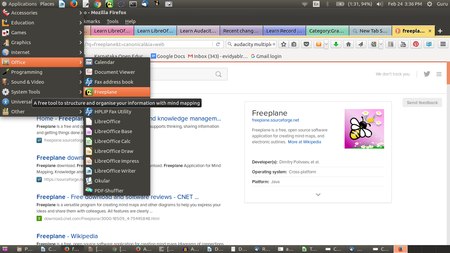Difference between revisions of "Teachers' toolkit for creating and re-purposing OER using FOSS/Text OER"
m |
|||
| Line 274: | Line 274: | ||
In the last chapter on ‘Publishing OER’, we will explain how you can upload these resources on the world wide web, which can be considered as the ‘Global Digital Library’ accessible to anyone with connectivity. | In the last chapter on ‘Publishing OER’, we will explain how you can upload these resources on the world wide web, which can be considered as the ‘Global Digital Library’ accessible to anyone with connectivity. | ||
| + | |||
| + | [[Category:Teachers' toolkit for creating and re-purposing OER using FOSS]] | ||
Revision as of 16:59, 25 February 2017
Objectives
In this chapter, you will learn how to create and re-purpose text OER. You will learn
- about popular repositories for accessing text OER
- to access, create and re-purpose text resources using a text editor (LibreOffice Writer).
- to present text resources in a ‘slide presentation’ format (LibreOffice Impress).
- to access, create and re-purpose concept maps using concept map editor (Freeplane)
Accessing text OER repositories
The Internet is a rich source of text OER. Two ways in you can access text OER are explained below.
- The most popular text OER repository is the digital encyclopedia, Wikipedia. You can access Wikipedia on http://http://en.wikipedia.org. Wikipedia is available in more than hundred other languages, so you may also be able to search for text OER in your native language. You can search for your topic in Wikipedia, by simply typing this text in the search bar. We will do this for ‘Digital Story Telling’ (DST) which is the OER proposed to be created as an exemplar by this tool-kit.
Image to search and display DST on Wikipedia
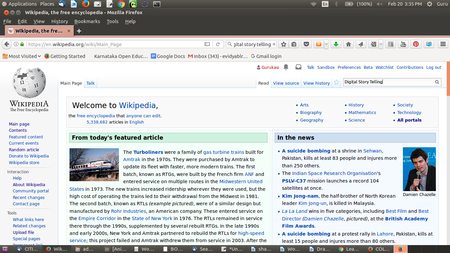
Other popular OER sites include http://www.wikieducator.org, https://oercommons.org. A list of OER sites is available on http://www.searchoer.com/list-of-oer.html
As you keep visiting these sites, you will get a better idea of the resources available so that you can narrow down your search to sites that have resources relevant to your topic.
- You can use a search engine such as Google search engine or DuckDuckGo search engine, using a web browser such as Mozilla Firefox, to search for web pages containing the information about DST by simply typing in Digital Story Telling in the search bar of the search engine.
Image to display DST using DuckDuckGo search engine
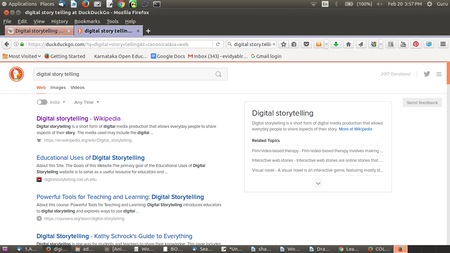
Image to display DST using Google search engine
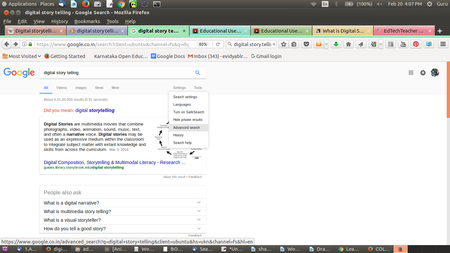
Similarly, you should enter the topic on which you want to access resources on, in the search engine search bar.
Note – the search engine will retrieve web pages for your topic that are both OER and non OER.
When you visit the site, you need to look for copyright information to ascertain that the resource is OER and you can re-use it. If the resource is not explicitly declared to be an OER (allowing you to re-use), you should not use it in making your OER.
This can be made easier by providing OER as a criteria in your search itself. In Google search you need to select Settings → Advanced Search. In Advanced Search, you can select Usage Rights as ‘free to use, share or modify, even commercially’ to get OER that you can re-use with or without modification.
Image to specify licensing while using Google search engine
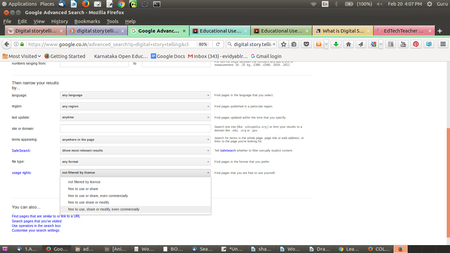
Creating a text OER - a concept map
You will begin your text OER creation by creating a concept map on the topic you have chosen to prepare an OER. A concept map is a visual representation of different concepts and their inter-connections. Concepts acquire power and meaning when they are connected to other concepts. Hence, organizing the concepts relevant to your topic is an important first step of OER creation.
A concept map provides a pictorial overview of the concepts, related concepts / sub-concepts for a topic. Your concept map OER for your topic will help you coherently and comprehensively organize your thinking about the concepts and sub-concepts that comprise your topic. This concept map can provide a useful ‘blue-print’ for creating your OER. In fact before you do any writing (or teaching) you should prepare a concept map on the topic, to better organize your thoughts, the connection between your ideas, their flow and sequence etc. Making this a habit will be very helpful in your work, including in OER creation.
You will learn the following using the FOSS application Freeplane
- Creating a concept map
- Inserting a hyper-link
- Inserting a note
Open Freeplane on your computer, through Applications → Office → Freeplane.
Creating a concept map using Freeplane
You can create a concept map using the FOSS tool ‘Freeplane’.
Open Freeplane, select Applications → Office →Freeplane
Create the nodes for the topics and sub topics as per your thinking about the topic. Use the ‘insert’ key to create a ‘child node’ this is a sub-concept of your current concept. Use the ‘enter’ key to create a ‘sibling’ this is a parallel concept to your current concept. Thus you can create a concept map with knowing just two functions – add child node (insert) and add sibling node (enter).
Image to display – Creating a concept map using Freeplane
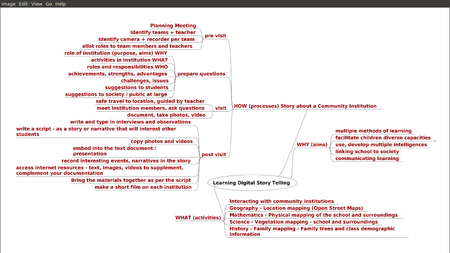
We will create a concept map on ‘Learning Digital Story Telling’ with Freeplane. We will save the concept map in the folder ‘Learning Digital Story Telling’ as Learning Digital Story Telling.mm. The extension .mm stands for mindmap. Our map has nodes for the ‘why’, ‘what’ and ‘how’ of DST, with sub-nodes. The main node has a hyper-link which opens the wikipedia page on DST.
Likewise, please create a concept map and save it with the same name in your folder you have created with your topic name. Note that simply saving the file will save it with the name you have given in the root node. Create the sub-nodes for each node as per your imagination / thinking about the topic. Finally export the concept map to an image format. We will discuss how you can use this image in the next chapter.
Image to display – DST concept map created using Freeplane
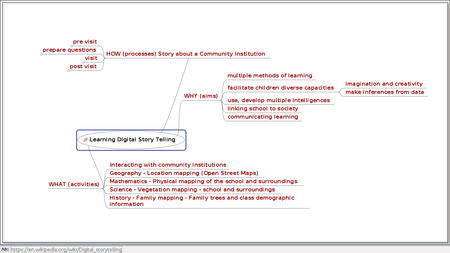
Inserting a hyper-link
You can embed a hyper-link on a node, such that clicking that node will open a page on the Internet or a file on your computer). This connects a node on your map to related resources you may want the reader to access.
In our Learning Digital Story Telling.mm concept map, we will insert a hyper-link for the main node ‘Learning Digital Story Telling’. Move your cursor to this node and select Edit → Link → Add or Modify hyperlink (type). You can also use the keyboard shortcut CTRL-K. Freeplane will open an input bar. We will type in our webpage address https://en.wikipedia.org/wiki/Digital_storytelling into this input bar
Image to display – Inserting hyper link in Freeplane
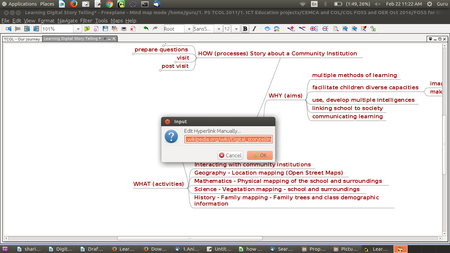
You should identify a useful web resource for any one node. You should similarly insert this hyper link for that node following the same steps. Note that Freeplane provides a pink arrow in the node, to signify that the node has a hyper link. Clicking on this pink arrow will open the web page that is linked. In this manner, your concept map OER can provide links for each node, to access information on the world wide web, enriching the OER.
Inserting a note
It is useful to also insert notes for a node, which can provide a more detailed explanation, or an annotation for that node.
You can also add notes to a node to add more description to a node. To do this, you need to go to "View" and select "Note Window". This will open a box where you can enter text. You can adjust the size of this box. To enter a note, select a node and enter the notes below in the note window.
In our Learning Digital Story Telling.mm concept map, we will insert a note for the main node ‘Learning Digital Story Telling’ as follows
“Digital storytelling involves using images, narration and music to tell a story. It includes writing a story, adding images / photos, audio clips and preparing a video finally. The production of these images, audio and video will involve many software applications”.
Image to display – Inserting note in Freeplane
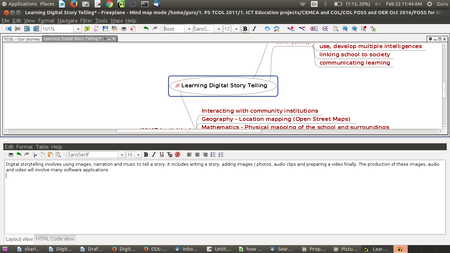
You should prepare a note any one node. You should similarly insert this note for that node following the same steps. Note that Freeplane provides a yellow sheet in the node, to signify that the node has a note. Moving the mouse over this sheet will display the note. In this manner, your concept map OER can provide notes for each node, to provide richer and more detailed information for that node. (Advanced tip – If you export your concept map as a ‘odt’ or ‘doc’ text file, your note will be added to the section created for the node).
Note that this tool-kit is not intended to provide the complete user manual for the applications explained. The aim here is to get you started with concept map OER creation using Freeplane. For advanced functions, you should refer to the User Manual for the application. The Freeplane tutorial is available within Freeplane itself, which you can access anytime by pressing the F1 function key.
Freeplane on other platforms
Freeplane is also available on Microsoft Windows, on https://freeplane.en.softonic.com/download
In Android Mobiles we can view concept maps through Freeplane reader
https://en.wikipedia.org/wiki/Freeplane has more information about Freeplane.
Creating text OER (LibreOffice Writer)
You are familiar with typing text to create a text document, you may have used a software like Microsoft Word. We will use the FOSS Office suite LibreOffice and Writer (LibreOffice Writer) is the text editor in this suite.
Open LibreOffice Writer on your computer, through Applications → Office – LibreOffice Writer.
Image opening LibreOffice Writer
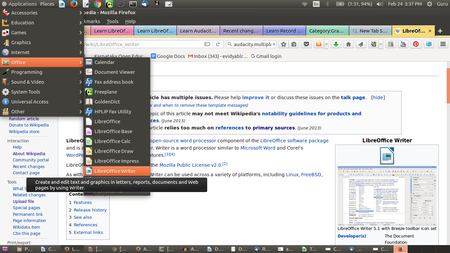
Creating a text OER document
You should create a ‘new’ document, giving the topic name.
We create a text document - ‘Learning Digital Story Telling’. Create a folder on your computer “Digital Story Telling OER”. Save “Learning Digital Story Telling” in this folder. Saving this document, creates a text document “Learning Digital Story Telling.odt” where odt stands for Open Document Text.
The concept map that you have prepared for your topic can give you a plan for writing the text document. You will also referr to the OER text resources from Wikipedia and other sites for your topic that you have searched.
Image to display – Creating a text document, creating four sections using LibreOffice Writer
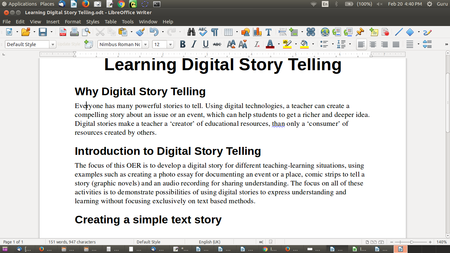
You can similarly create your own text OER. You will learn the following basic functions in a text editor which you need to use in creating OER.
- Entering text
- Formating text
- Inserting a numbered list
- Inserting a table / box item
- Insert page numbers
- Insert section headings
Entering text
You can enter text by simply typing into this document. In our document, we have entered text under following four paragraphs
- Why Digital Story Telling
- Introduction to Digital Story Telling
- Creating a simple text story
- Adding a concept map on ‘Digital Story Telling’
Formating text
You can format your text in many ways. Click on the Format menu option of LibreOffice Writer to see the options. Commonly used formating includes selecting text to highlight it through the ‘bold’ ‘italic’ or ‘underline’ functions. You can change the font, font colour and font size of select text as well. All these can be done through the Format → Text menu, or by clicking the relevant icon in the menu tool bar. Remember to select the text before clicking on these options.
Image to display – Formatting a text document using LibreOffice Writer
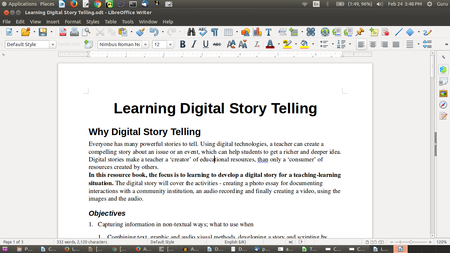 Text highlighted (bold) |
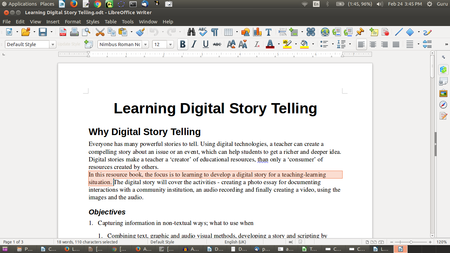 Formating text by highlighting |
Inserting a numbered list
You may be making a list of items in your document. Instead of manually entering the numbers, you could use automatic numbering.
You can select Format → Bullets and Numbering and select the numbering type you want.
In our document, we have created a numbered list under Objectives.
Image to display – Inserting a numbered list using LibreOffice Writer
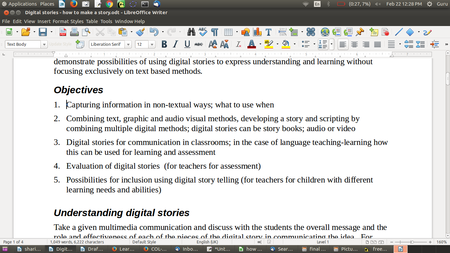
You can also type the text first and then select the entire text typed and then click Format → Bullets and Numbering. Hit the ‘enter’ key to go to the next line with the next number. For indenting and sub numbering, you can use the ‘Tab’ key.
In our document, we have created a numbered list under Objective 1.
Image to display – Inserting a numbered list with sub numbering using LibreOffice Writer

Inserting a table / box item
You may want to put a specific information inside a box to highlight it separately. You can also use box to provide additional information, which the reader may skip, if they want to read the article quickly.
You can select Table. Select number of rows and number of columns as ‘1’. You will get a box (which is nothing but a table with one row and one column). Enter your text in this box
In our document, we have created a box for providing the license information for the document.

You should create a box for providing similar license information for your document. You can insert this box at the beginning of the document.
It is useful to have page number and name of your document on every page, this is specially useful if the reader wants to read a hard copy (print out). LibreOffice Writer allows you to easily insert this information at the bottom or top of each page. You can select Format → Page and then the Header or Footer tab in the Page form, to enable the Header or Footer for your document.
You can then simply go to the bottom of a page of your document and click the cursor there, to open the Footer. You can type your document name on the left side and then select Insert → Page Number on the right side of the footer. You can type any text in this footer, it will come on all pages. Other than page number, other dynamic information you can provide is the date/time stamp of the document.
In our document, we have inserted the document name and page number in the footer.
Image to display – Inserting document name and page number in the footer
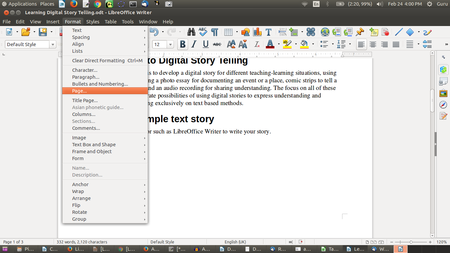 Format page to add footer |
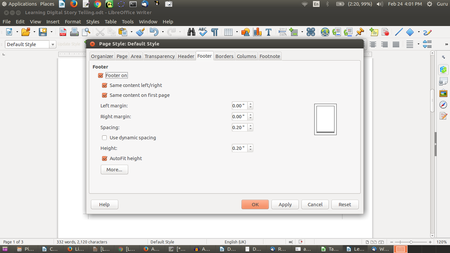 Format page to add footer 2 |
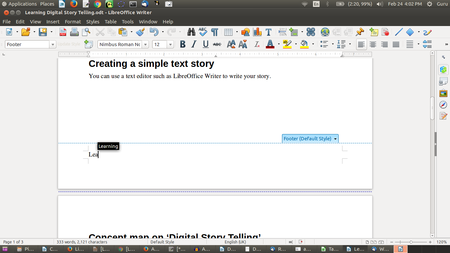 Entering footer information in a document |
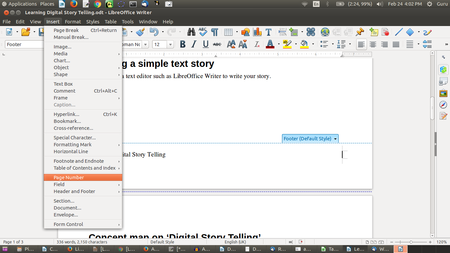 Inserting page number in footer in a document |
You should insert a footer for your document.
Insert section headings
You can create sections headings in your document. Select the section heading and then click on Styles. You will see Heading 1, Heading 2 etc.
Image to display – Inserting section headings
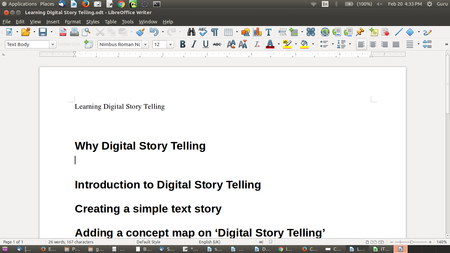
You should insert a section headings for your document.
Continuing editing text OER
You can re-open this file from this folder anytime to continue editing your text document using LibreOffice Writer. You can add, move, modify and remove text. You can format your text in different ways. In this way, you can keep enhancing your text OER on your topic regularly.
Note that this tool-kit is not intended to provide the complete user manual for the applications explained. The aim here is to get you started with OER creation using the tool. For advanced functions, you should refer to the User Manual for the application. The LibreOffice Writer User Manual is available on https://help.libreoffice.org/Writer/Welcome_to_the_Writer_Help
Short videos on LibreOffice Writer are available on http://spoken-tutorial.org/tutorial-search/?search_foss=LibreOffice+Suite+Writer&search_language=English. Each video is less than 10 minutes and focuses on select features of the application.
LibreOffice Writer on other platforms
LibreOffice Writer is also available on Microsoft Windows, on http://www.libreoffice.org/download/download. LibreOffice Writer is part of the LibreOffice suite on Windows
In Android Mobiles we can view text documents through "OpenDocumentReader" App or WPS Office App
https://en.wikipedia.org/wiki/LibreOffice_Writer has more information about LibreOffice Writer.
Creating a slide presentation (LibreOffice Impress)
A slide presentation is a useful method of sharing information, or in training or teaching. Once your text document on OER is fully complete (You will continue to add text and resources in other formats, in the subsequent sections), you can bring the highlights of the content on slides in bullet points. You can embed images, audio links, video links in the presentation. You can do a ‘slide show’ of this presentation while engaging your learners.
We create a slide presentation - ‘Learning Digital Story Telling’ using LibreOffice Impress (LibreOffice Impress).
Open LibreOffice Writer on your computer, through Applications → Office – LibreOffice Impress.
Image opening LibreOffice Impress
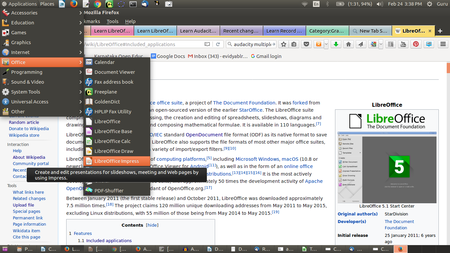
You will learn the following basic functions in LibreOffice Impress which you need to use in creating OER.
- Managing slides
- Entering text
- Formating text
- Inserting a numbered list
- Inserting a text box
Managing slides
A slide presentation is a document that consists of slides, each slide can be considered as a ‘page’ which will contain a coherent set of information, usually presented as bulleted points.
You can create a slide presentation with as many slides (Slide → Create New slide) as you want using LibreOffice Impress. You can duplicate a slide (Slide → Duplicate Slide) if you want to create a slide using the contents (or the format) of another slide. You can move slides across using the drag-drop in the slide sorter view (View → Slide Sorter).
Image to display – Creating a slide presentation, using LibreOffice Impress
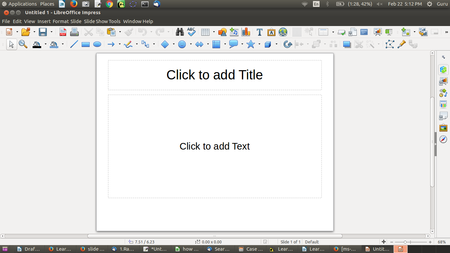
Entering text, formating text, inserting a numbered list and inserting a text box
A useful feature of the LibreOffice suite is that the Writer and Impress products are fully integrated and have the same interface. When you select File → Open, you get to chose if you will create a text file or a presentation file. Hence, these four functions mentioned above for LibreOffice Impress are identical to perform as was explained in the LibreOffice Writer section.
In our slide presentation, we have entered text (by simply typing the text) and formatted text (changed font colour – Format → Character → Font Effects → Font color) on the first slide.
Image to display – DST slide presentation, entering and formating text using LibreOffice Impress
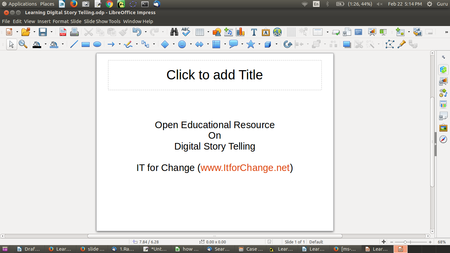
In the second slide, we copy pasted the objectives from our text file. We created a numbered list (Selecting the text and then → Format → Bullets and Numbering → Numbering Type).
We have also inserted a text box (Insert → Shape → Basic → Rectangle) at the bottom of the slide and typed the text ‘Can you suggest more possible objectives of DST?’. The background colour in this box is blue, to change the colour, select Format → Style → Edit Style → Area. Select the colour you want (white is a good background). Similarly, if you do not want a border for the text box, you can remove it. Select Format → Style → Edit Style → Line → Style → None.
Image to display – DST slide presentation, creating a numbered list and inserting a text box using LibreOffice Impress
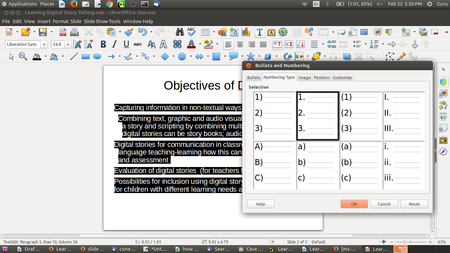
LibreOffice Impress on other platforms
LibreOffice Impress is also available on Microsoft Windows, on http://www.libreoffice.org/download/download. LibreOffice Impress is part of the LibreOffice suite on Windows
In Android Mobiles we can view text documents through "OpenDocumentReader" App or WPS Office App
https://en.wikipedia.org/wiki/LibreOffice_Impress has more information about LibreOffice Impress.
Short videos on LibreOffice Impress are available on http://spoken-tutorial.org/tutorial-search/?search_foss=LibreOffice+Suite+Impress&search_language=English. Each video is less than 10 minutes and focuses on select features of the application.
Alternative FOSS applications
- Freemind is an alternative to Freeplane for making concept maps. Its features and interface is similar to Freeplane.
- An alternative to LibreOffice for creating text resources and slide presentations is OpenOffice.org. OpenOffice.org also has a similar Writer and Impress applications.
- gedit is a plain text editor. If you are copying content from a website into your LibreOffice Writer document and the formatting is very messed up, you could instead copy from the website and paste into a gedit file and then copy from the gedit file to your LibreOffice Writer document, this will remove all formatting and help you organize the text more easily.
PDL to store the OER in your computer
As a part of using this tool-kit to learn FOSS tools and create OER, we will be accessing and creating many documents / files. It is necessary to organize these files carefully on our computer so that we can access them easily later. You have already created a folder in your computer with your topic name. You should make sub folders for ‘Text OER’, ‘Image OER’ and ‘Audio Video OER’ within this folder, giving full folder names such as ‘Text OER for <my topic> etc, and use these to save your text, image, audio and video files respectively. By organizing your files and folders carefully on any topic, you are creating what can be termed as a ‘Personal Digital Library’ (PDL) on that topic. Having PDLs on different topics on your computer will enable you to use these easily and effectively for your teaching and learning activities.
In the last chapter on ‘Publishing OER’, we will explain how you can upload these resources on the world wide web, which can be considered as the ‘Global Digital Library’ accessible to anyone with connectivity.
